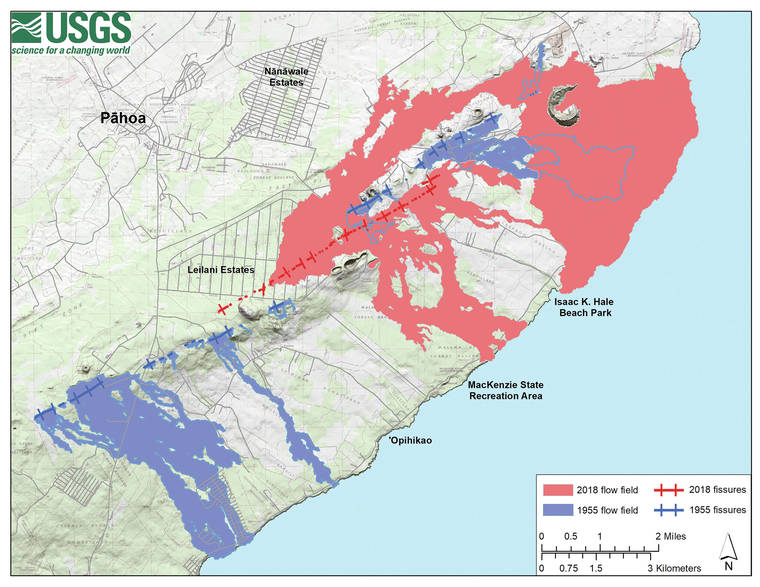February 28, 2020, marks the 65th anniversary of Kilauea Volcano’s 1955 lower East Rift Zone (LERZ) eruption. In recognition of this historic event, we look back at the eruption and compare it to what happened in 2018.
Increased seismic activity and ground deformation began at Kilauea’s summit in January 1953. Despite a short (4-day) summit eruption in May 1954, the summit continued to pressurize, and by August 1954, summit inflation was at its highest levels since 1924.
Following two large earthquakes in the south Puna District in March 1954, the Hawaiian Volcano Observatory deployed a seismograph at Pahoa School to monitor increased seismic activity in the region. Months later, that seismic station began recording many small earthquake swarms near the town of Pahoa.
By February 24, 1955, the Pahoa seismograph was recording 130 earthquakes a day. That daily number quickly rose to 700 earthquakes just three days later, and HVO scientists thought an eruption in the area was imminent.
Lava erupted from the first LERZ fissure near Pu‘uhonua‘ula at 8 a.m. local time on Feb. 28. Fourteen additional fissures then opened down-rift of the first. By the time the eruption waned on the morning of March 7, several lava flows had crossed Highways 132 and 137, as well as the Pahoa-Pohoiki road, isolating Kapoho Village.
The eruption paused for six days, and then a new fissure opened approximately 3 km (1.8 mi) up-rift, near Kali‘u, on the evening of March 12. An additional eight fissures opened along this up-rift trend.
The 1955 eruption abruptly ended on May 26 around 11:15 a.m., following the sudden termination of seismic tremor. Overall, nearly 2 km (1.2 miles) of Highway 130 were cut by lava flows. Three lava lobes reached the ocean, covering sections of Highway 137 and cutting access to Kalapana in the process.
So how do the events of Kilauea Volcano’s 1955 LERZ eruption compare with its 2018 LERZ eruption?
The 1955 eruption lasted 88 days, with a brief (6-day) pause in activity after the first week. An additional two-week pause occurred in April, during which the coastal road to Kalapana was reopened. The eruption then resumed for another month, producing intermittent lava fountains up to 60 m (200 ft) high from several vents. During this renewed activity, lava ponded between two of the fissures. The lava pond eventually spilled over, producing multiple flows that crossed Highway 130 again, but stopped short of crossing Highway 137 and isolating Kalapana for a second time.
Kilauea’s 2018 LERZ eruption lasted 124 days. It also paused briefly for several days soon after the eruption started, with a longer pause of approximately two weeks near the end of the eruption. However, the lava activity that resumed within the fissure 8 cone in 2018 was weak and lasted only about five days before ceasing.
Both eruptions opened 24 fissures that erupted lava. But, the estimated volume of lava erupted in 2018 was roughly seven times greater than that erupted in 1955.
The 1955 lava flows covered about 15.8 sq km (6.1 square miles) of land, burying around 10.1 km (6.3 mi) of roads and destroying 21 homes. In 2018, lava flows covered about 35.5 sq km (13.7 square miles) of land, burying 48.3 km (30 mi) of roads and destroying 723 structures.
In 1955, HVO’s monitoring network on Kilauea was sparse, but tilt measurements on the north rim of Kilauea Crater recorded subsidence at the summit of the volcano. This subsidence, a result of the 1955 LERZ eruption, must have been more than 0.5 m (1.4 ft).
Prior to the 2018 LERZ eruption, a 10-year-long eruption persisted in Halema‘uma‘u, a crater within the caldera atop Kilauea. This 2008–2018 eruption ended when magma drained from the summit magma reservoir in response to the LERZ eruption, which led to caldera collapses. The maximum subsidence recorded at Kilauea’s summit in 2018 exceeded 500 m (1600 ft).
Summit and rift zone eruptions are common in Kilauea Volcano’s geologic history. Per the guiding geologic principle that “the past is the key to the future,” the 1955 LERZ eruption helped HVO scientists better understand the 2018 LERZ eruption. In turn, what we learned in 2018 will help us better understand future Kilauea LERZ eruptions.
Volcano
activity updates
Kilauea Volcano is not erupting. Its USGS Volcano Alert level remains at NORMAL. Updates for Kilauea are now issued monthly.
Kilauea monitoring data over the past month showed no significant changes. Rates of seismicity were variable but within long-term values. Sulfur dioxide emission rates were low at the summit and below detection limits at Pu‘u ‘O‘o and the lower East Rift Zone. The water lake at the bottom of Halema‘uma‘u continued to slowly expand and deepen.
Mauna Loa is not erupting. Its USGS Volcano Alert level remains at ADVISORY. This alert level does not mean that an eruption is imminent or that progression to an eruption is certain.
This past week, about 80 small-magnitude earthquakes were recorded beneath the upper elevations of Mauna Loa; the strongest was a M2.9 quake on Feb. 27. Deformation indicates continued slow summit inflation. Fumarole temperature and gas concentrations on the Southwest Rift Zone remain stable.
Mauna Loa updates are issued weekly. For more info, please go to: https://volcanoes.usgs.gov/volcanoes/mauna_loa/status.html
No earthquakes were reported felt in the Hawaiian Islands this past week.
HVO continues to closely monitor both Kilauea and Mauna Loa for any signs of increased activity.
Please visit HVO’s website (https://volcanoes.usgs.gov/hvo) for past Volcano Watch articles, Kilauea and Mauna Loa updates, volcano photos, maps, recent earthquake info, and more. Email questions to askHVO@usgs.gov.
Volcano Watch (https://volcanoes.usgs.gov/hvo/hvo_volcano_watch.html) is a weekly article and activity update written by U.S. Geological Survey Hawaiian Volcano Observatory scientists and affiliates.






